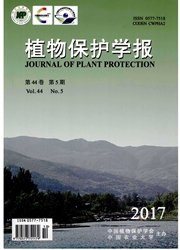

 中文摘要:
中文摘要:
为明确我国黄瓜花叶病毒株系分化及系统进化基本情况,从湖南、新疆、青海和海南4省区采集1 367个样品对其进行酶联免疫和RT-PCR检测,并对分离获得的15个黄瓜花叶病毒(Cucumber mosaic virus,CMV)纯化分离物CP、MP、2b核苷酸序列进行相似性和进化树分析及生物学性状比较。结果表明,辣椒、龙葵和黄瓜的CMV阳性检出率较高,分别为54.13%、29.19%和18.46%。进化树分析显示CMV-Q5与CMV亚组II的亲缘性较高;CMV-N7为新发现的重组株系,其CP、2b基因属于CMV亚组IB,MP基因却属于CMV亚组II;其余13个分离物均属于CMV亚组IB。CMV-N7和CMV-Q5在系统寄主心叶烟和枯斑寄主苋色藜上引发的症状相似,但比对照株系CMV-P3613(IB)的发病时间要晚1-2 d,系统花叶较温和,枯斑较小。表明在以上4省区常见农作物上广泛流行的CMV存在分子变异。
 英文摘要:
英文摘要:
In order to explore the strain differentiation and phylogenetic characteristics of Cucumber mosaic virus( CMV) in China,1 367 samples displaying relevant symptoms from Hunan,Xinjiang,Qinghai and Hainan were detected by using enzyme-linked immunosorbent assay( ELISA) and reverse transcription-polymerase chain reaction( RT-PCR) methods. The results showed that the CMV detection rates of chili,Chenopodium amaranticolor and cucumber plants were 54. 13%,29. 19% and 18. 46%,respectively. Moreover, 15 isolates of CMV were obtained through biological purification. The phylogenetic analysis based on nucleotide sequences of 2b,CP and MP showed that CMV-Q5 was classified as CMV subgroup II; CMV-N7 was a new natural reassortant between CMV subgroups,with its CP and 2b being derived from CMV subgroup IB,while MP was derived from CMV subgroup II. Other13 isolates were classified as CMV subgroup IB. Compared with CMV-P3613( IB) standard strain,CMVN7 and CMV-Q5 were significantly different in biological characteristics as their infection symptoms were milder and appeared two days later on Nicotiana glutinosa and Chenopodium amaranticolor. These resultsindicated that the CMV isolates infecting common crops in the four regions presented some molecular variation.
 同期刊论文项目
同期刊论文项目
 同项目期刊论文
同项目期刊论文
 期刊信息
期刊信息
